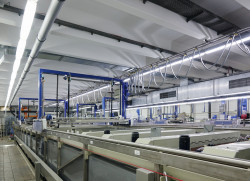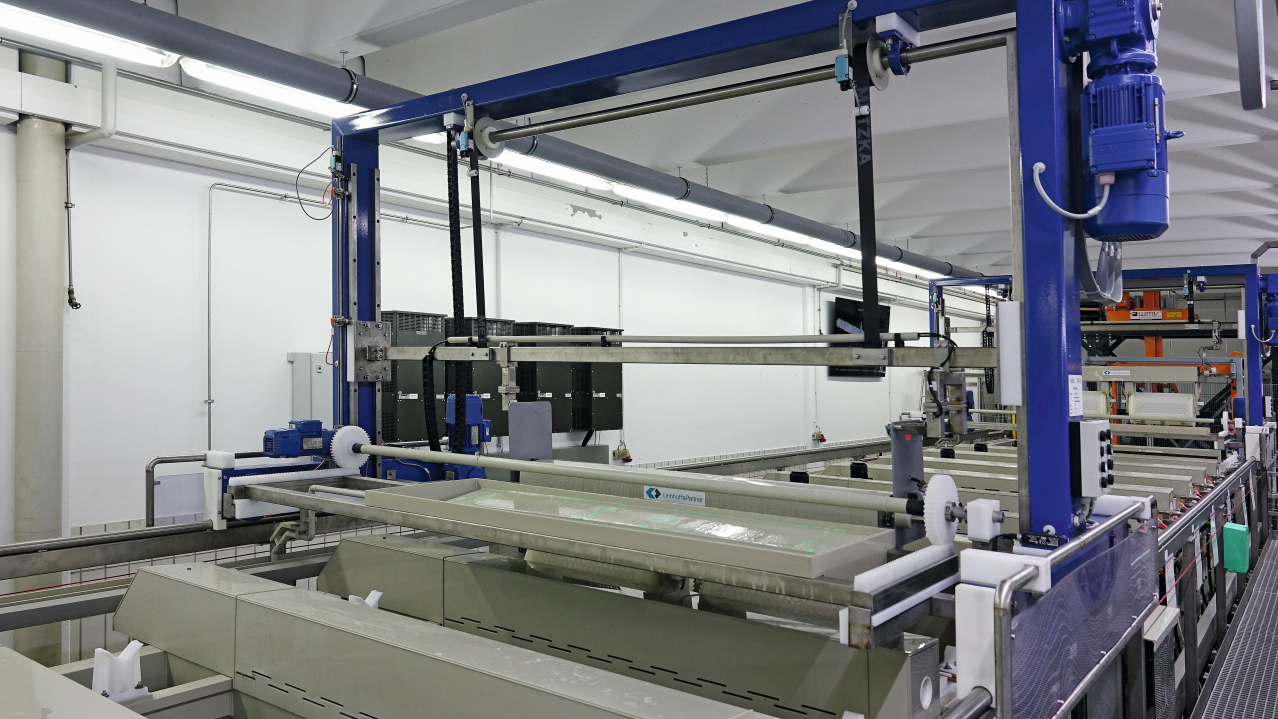Investing in new electroplating systems is always associated with challenges for companies. The systems need to be commissioned on time and be permanently efficient, innovative, resource-saving and reliable. Choosing the right plant manufacturer is therefore particularly important.
They must understand the customer's requirements and build the best possible system for the customer within the planned timeframe. To do this, the plant manufacturer - in this case Metzka from Schwanstetten - must take many factors into account: Which electroplating technology is used, which operating temperatures and chemical media are used and which construction materials enable the highest process and operational reliability under these operating conditions.
ODU - a global presence with connectors
 Fig. 1: Double-drum machine with automated drying and coating system using centrifugal technology ODU is one of the leading international suppliers of connector systems and employs 2,500 people worldwide. The group is headquartered in Mühldorf am Inn, about 80 kilometers east of Munich. ODU also has other production and logistics sites around the world - in Sibiu/Romania, Camarillo/USA, Shanghai/China and Tijuana/Mexico.
Fig. 1: Double-drum machine with automated drying and coating system using centrifugal technology ODU is one of the leading international suppliers of connector systems and employs 2,500 people worldwide. The group is headquartered in Mühldorf am Inn, about 80 kilometers east of Munich. ODU also has other production and logistics sites around the world - in Sibiu/Romania, Camarillo/USA, Shanghai/China and Tijuana/Mexico.
Here, a system was requested specifically for e-mobility charging plugs using barrel technology for Cu, Ni and Ag plating. In addition to electroplating, special requirements were placed on the application of the tarnish protection as a post-treatment of the final silver layer. This process was to be realized with a subsequent drying process using centrifuge technology. A double-drum machine with an automated drying and coating system using centrifugal technology from the wet converter to the automatic tipping station was planned and designed.
INFO
Surface systems from Metzka
- Conservation of resources through heat recovery, heat exchangers, vacuum distillation and recirculation of rinsing water
- State-of-the-art 2D/3D goods movement systems and safety technology
- Radio transmission systems for drum rotation and vibroset monitoring
- Online control of baths using photometric measuring methods
This technology was developed and successfully implemented together with Metzka's partner WMV (Fig. 1).
The results of the first batches were quite satisfactory with regard to the requirements set. The parts meet and exceed expectations in terms of quality such as layer thickness distribution, adhesive strength, hardly any impact marks and dryness. Metzka has already delivered the system (2x frame / 4 x vibro-drum frame / 1x double drum) to ODU Oberflächentechnik.
The major challenge for WMV was the limited space on site and the handling of the passivation medium. Proven technology could not be used due to the specifications for handling the chemicals and the comparatively small batch sizes. However, WMV resorted to components that had already been used elsewhere in the past for similar tasks.
And so, after several coordination meetings, ODU and Metzka developed a suitable concept that met expectations right from the start and confirmed the tests carried out by ODU in advance.
 Fig. 2: Centrifugal system in which the passivation process takes placeTheoutsourcing of the passivation process to the downstream centrifuge system (Fig. 2) results in a few decisive advantages. The centrifuge drum leaves the coating station largely drip-free and dry after the passivation process. The passivation bath is not diluted or contaminated by carry-over within the system. This results in a considerable increase in bath service life and a significant reduction in costs. In principle, the goods leave each station drip-free, even after the transfer of goods from Metzka, which is carried out in a funnel flooded with water to protect the material.
Fig. 2: Centrifugal system in which the passivation process takes placeTheoutsourcing of the passivation process to the downstream centrifuge system (Fig. 2) results in a few decisive advantages. The centrifuge drum leaves the coating station largely drip-free and dry after the passivation process. The passivation bath is not diluted or contaminated by carry-over within the system. This results in a considerable increase in bath service life and a significant reduction in costs. In principle, the goods leave each station drip-free, even after the transfer of goods from Metzka, which is carried out in a funnel flooded with water to protect the material.
The drying process that takes place at the end of the process can be carried out very effectively and efficiently in the centrifuge. Monitoring of the centrifuge exhaust air allows the drying process to be ended in good time and reduces the heating energy used to dry the goods to a minimum.
Gentle emptying of the fabric at the end rounds off the process. Subsequent washing of the drum prevents adhering chemicals from being carried back into the wet filling area and further into the electroplating process.
 Metzka Managing Director Heike Metzka-Bauer
Metzka Managing Director Heike Metzka-Bauer
INFO
Metzka at a glance
- Know-how from a single source thanks to more than 40 years of uninterrupted market presence
- Above-average vertical range of manufacture, i.e. in-house production in detail
- Owner-managed - short, quick and competent decisions
- Durable, valuable and reliable systems with expert service, maintenance and training
- Metzka covers the entire spectrum with its own in-house electroplating technicians, thinks holistically and focuses on the customer


